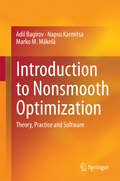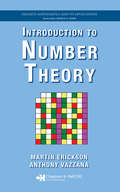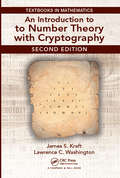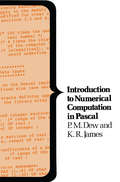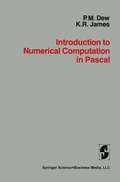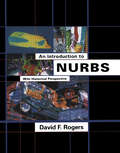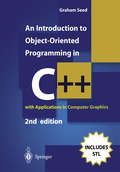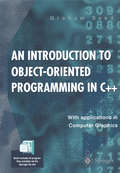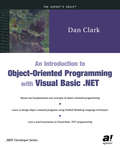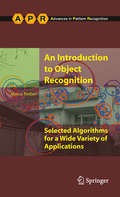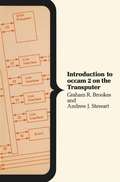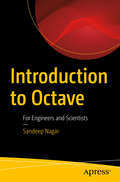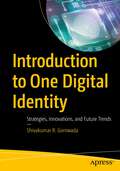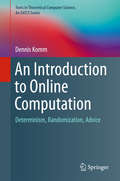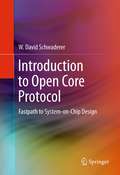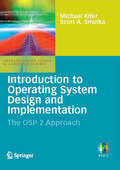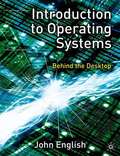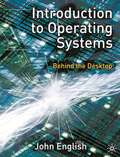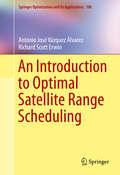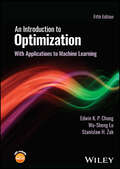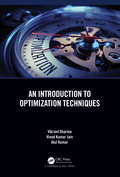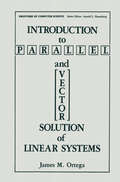- Table View
- List View
Introduction to Nonsmooth Optimization: Theory, Practice and Software
by Adil Bagirov Napsu Karmitsa Marko M. MäkeläThis book is the first easy-to-read text on nonsmooth optimization (NSO, not necessarily differentiable optimization). Solving these kinds of problems plays a critical role in many industrial applications and real-world modeling systems, for example in the context of image denoising, optimal control, neural network training, data mining, economics and computational chemistry and physics. The book covers both the theory and the numerical methods used in NSO and provide an overview of different problems arising in the field. It is organized into three parts:1. convex and nonconvex analysis and the theory of NSO;2. test problems and practical applications;3. a guide to NSO software.The book is ideal for anyone teaching or attending NSO courses. As an accessible introduction to the field, it is also well suited as an independent learning guide for practitioners already familiar with the basics of optimization.
Introduction to Number Theory
by Anthony VazzanaOne of the oldest branches of mathematics, number theory is a vast field devoted to studying the properties of whole numbers. Offering a flexible format for a one- or two-semester course, Introduction to Number Theory uses worked examples, numerous exercises, and two popular software packages to describe a diverse array of number theory topi
An Introduction to Number Theory with Cryptography (Textbooks in Mathematics)
by James Kraft Lawrence WashingtonBuilding on the success of the first edition, An Introduction to Number Theory with Cryptography, Second Edition, increases coverage of the popular and important topic of cryptography, integrating it with traditional topics in number theory. The authors have written the text in an engaging style to reflect number theory's increasing popularity. The book is designed to be used by sophomore, junior, and senior undergraduates, but it is also accessible to advanced high school students and is appropriate for independent study. It includes a few more advanced topics for students who wish to explore beyond the traditional curriculum.
An Introduction to Number Theory with Cryptography (Textbooks in Mathematics)
by James Kraft Lawrence WashingtonBuilding on the success of the first edition, An Introduction to Number Theory with Cryptography, Second Edition, increases coverage of the popular and important topic of cryptography, integrating it with traditional topics in number theory. The authors have written the text in an engaging style to reflect number theory's increasing popularity. The book is designed to be used by sophomore, junior, and senior undergraduates, but it is also accessible to advanced high school students and is appropriate for independent study. It includes a few more advanced topics for students who wish to explore beyond the traditional curriculum. Features of the second edition include Over 800 exercises, projects, and computer explorations Increased coverage of cryptography, including Vigenere, Stream, Transposition,and Block ciphers, along with RSA and discrete log-based systems "Check Your Understanding" questions for instant feedback to students New Appendices on "What is a proof?" and on Matrices Select basic (pre-RSA) cryptography now placed in an earlier chapter so that the topic can be covered right after the basic material on congruences Answers and hints for odd-numbered problems About the Authors: Jim Kraft received his Ph.D. from the University of Maryland in 1987 and has published several research papers in algebraic number theory. His previous teaching positions include the University of Rochester, St. Mary's College of California, and Ithaca College, and he has also worked in communications security. Dr. Kraft currently teaches mathematics at the Gilman School. Larry Washington received his Ph.D. from Princeton University in 1974 and has published extensively in number theory, including books on cryptography (with Wade Trappe), cyclotomic fields, and elliptic curves. Dr. Washington is currently Professor of Mathematics and Distinguished Scholar-Teacher at the University of Maryland.
Introduction to Numerical Computation in Pascal
by DEW/JAMESOur intention in this book is to cover the core material in numerical analysis normally taught to students on degree courses in computer science. The main emphasis is placed on the use of analysis and programming techniques to produce well-designed, reliable mathematical software. The treatment should be of interest also to students of mathematics, science and engineering who wish to learn how to write good programs for mathematical computations. The reader is assumed to have some acquaintance with Pascal programming. Aspects of Pascal particularly relevant to numerical computation are revised and developed in the first chapter. Although Pascal has some drawbacks for serious numerical work (for example, only one precision for real numbers), the language has major compensating advantages: it is a widely used teaching language that will be familiar to many students and it encourages the writing of clear, well structured programs. By careful use of structure and documentation, we have produced codes that we believe to be readable; particular care has been taken to ensure that students should be able to understand the codes in conjunction with the descriptive material given in the book.
An Introduction to NURBS: With Historical Perspective (The Morgan Kaufmann Series in Computer Graphics)
by David F. RogersThe latest from a computer graphics pioneer, An Introduction to NURBS is the ideal resource for anyone seeking a theoretical and practical understanding of these very important curves and surfaces. Beginning with Bézier curves, the book develops a lucid explanation of NURBS curves, then does the same for surfaces, consistently stressing important shape design properties and the capabilities of each curve and surface type. Throughout, it relies heavily on illustrations and fully worked examples that will help you grasp key NURBS concepts and deftly apply them in your work. Supplementing the lucid, point-by-point instructions are illuminating accounts of the history of NURBS, written by some of its most prominent figures. Whether you write your own code or simply want deeper insight into how your computer graphics application works, An Introduction to NURBS will enhance and extend your knowledge to a degree unmatched by any other resource.Presents vital information with applications in many different areas: CAD, scientific visualization, animation, computer games, and more.Facilitates accessiblity to anyone with a knowledge of first-year undergraduate mathematics.Details specific NURBS-based techniques, including making cusps with B-spline curves and conic sections with rational B-spline curves.Presents all important algorithms in easy-to-read pseudocode-useful for both implementing them and understanding how they work.Includes complete references to additional NURBS resources.
An Introduction to Object-Oriented Programming in C++: with Applications in Computer Graphics
by Graham M. SeedThis book introduces the art of programming in C++. The topics covered range from simple C++ programmes to programme features such as classes, templates, and namespaces. Emphasis is placed on developing a good programming technique and demonstrating when and how to use the advanced features of C++. This revised and extended second edition includes: the Standard Template Library (STL), a major addition to the ANSI C++ standard; full coverage of all the major topics of C++, such as templates; and practical tools developed for object-oriented computer graphics programming. All code program files and exercises are ANSI C++ compatible and have been compiled on both Borland C++ v5.5 and GNU/Linux g++ v2.91 compilers. They are available from the author's web site.
An Introduction to Object-Oriented Programming in C++: With Applications in Computer Graphics
by Graham M. SeedWhy Another Book on c++ and why Programming and Graphics? Anyone who has browsed through the 'Computing' section of a bookshop (assuming it has one) will not need much convincing that there are a lot of C++ books out there. So why add yet another to the shelf! This book attempts to introduce you to the C++ language via computer graphics because the object-oriented programming features of C++ naturally lend themselves to graphics. Thus, this book is based around a central theme: computer graphics and the development of 'real' object-oriented tools for graphical modelling. This approach is adopted (as opposed to learning by small, unrelated, often hypothetical, examples) because I didn't want to introduce C++ as a collection oflanguage features. While introducing the syntax and features of C++, it is just as important to demonstrate simultaneously the reason for such features and when to apply them - in otherwords,language and design are given equal priority. Also, a key objective in writing this book is to present you with a comprehensive introductory text on programming in the C++ language.
An Introduction to Object-Oriented Programming with Visual Basic .NET
by Dan ClarkDan Clark shows beginning VB.NET programmers how one goes about architecting an object oriented programming solution aimed at solving a business problem.
An Introduction to Object Recognition: Selected Algorithms for a Wide Variety of Applications (Advances in Computer Vision and Pattern Recognition)
by Marco Alexander TreiberRapid development of computer hardware has enabled usage of automatic object recognition in an increasing number of applications, ranging from industrial image processing to medical applications, as well as tasks triggered by the widespread use of the internet. Each area of application has its specific requirements, and consequently these cannot all be tackled appropriately by a single, general-purpose algorithm. This easy-to-read text/reference provides a comprehensive introduction to the field of object recognition (OR). The book presents an overview of the diverse applications for OR and highlights important algorithm classes, presenting representative example algorithms for each class. The presentation of each algorithm describes the basic algorithm flow in detail, complete with graphical illustrations. Pseudocode implementations are also included for many of the methods, and definitions are supplied for terms which may be unfamiliar to the novice reader. Supporting a clear and intuitive tutorial style, the usage of mathematics is kept to a minimum. Topics and features: presents example algorithms covering global approaches, transformation-search-based methods, geometrical model driven methods, 3D object recognition schemes, flexible contour fitting algorithms, and descriptor-based methods; explores each method in its entirety, rather than focusing on individual steps in isolation, with a detailed description of the flow of each algorithm, including graphical illustrations; explains the important concepts at length in a simple-to-understand style, with a minimum usage of mathematics; discusses a broad spectrum of applications, including some examples from commercial products; contains appendices discussing topics related to OR and widely used in the algorithms, (but not at the core of the methods described in the chapters). Practitioners of industrial image processing will find this simple introduction and overview to OR a valuable reference, as will graduate students in computer vision courses. Marco Treiber is a software developer at Siemens Electronics Assembly Systems, Munich, Germany, where he is Technical Lead in Image Processing for the Vision System of SiPlace placement machines, used in SMT assembly.
Introduction to occam 2 on the Transputer (Computer Science Series)
by Graham R. Brookes Andrew J. StewartThe aim of this student text is to provide support for practical programming in concurrency, using the OCCAM 2 computer language. Although readers do not require previous experience of writing parallel computer programs, a general knowledge of programming techniques is assumed.
Introduction to Octave: For Engineers and Scientists
by Sandeep NagarFamiliarize yourself with Octave using this concise, practical tutorial that is focused on writing code to learn concepts. Starting from the basics, this book covers array-based computing, plotting, and working with files in Octave, which can run MATLAB files without modification. Introduction to Octave is useful for industry engineers, researchers, and students who are looking for open-source solutions for numerical computation.In this book you will learn by doing, avoiding technical jargon, which makes the concepts easy to learn. First you’ll see how to run basic calculations, absorbing technical complexities incrementally as you progress toward advanced topics. Throughout, the language is kept simple to ensure that readers at all levels can grasp the concepts. What You'll LearnApply sample code to your engineering or science problemsWork with Octave arrays, functions, and loops Use Octave’s plotting functions for data visualizationSolve numerical computing and computational engineering problems with OctaveWho This Book Is ForEngineers, scientists, researchers, and students who are new to Octave. Some prior programming experience would be helpful but not required.
Introduction to One Digital Identity: Strategies, Innovations, and Future Trends
by Shivakumar R. GoniwadaExplore the dynamics of digital identity, a crucial component in today’s modern technology-driven era. This engaging book offers a deep understanding of how digital identity is evolving rapidly, why it’s so significant, and offers organizations, regulatory bodies, and academicians the strategies needed to adopt secure decentralized digital identity features effectively. It’s a must-read for those aiming to grasp the intricacies of digital identity and leverage it for future innovation and security.The book begins by redefining digital identity, examining its evolution and the profound impact it has on both individuals and organizations. It then delves into the development of digital identity strategies, laying the foundation for future digital transformations. Covering a wide range of topics, the book discusses the innovation, challenges, and technological exploration in digital identity. A special focus is given to biometric technologies and the implementation of decentralized digital identities, addressing critical areas such as identity governance, blockchain, AI and advanced biometrics. The book also investigates the implications of digital identity across various industries, including cross border travel, healthcare, social media, finance, metaverse, IoT etc. finally the book provides not only emerging trends but offers a glimpse into the future digital identity. Whether you’re a tech professional, business leader, student or simply keen on understanding the impact of digital advancements, this book promises to offer insightful perspectives and practical solutions for navigating the complex world of digital identity. It underscores the importance of identity in spearheading digital innovation, making it a key resource for anyone looking to stay ahead in the digital landscape. As you reach its conclusion, you’ll be equipped with a wealth of knowledge and insights that are crucial in today’s digital era.What You'll LearnDigital identity strategies and their role in shaping the future of digital identityDifferent facets of digital identitySpecifics of biometric technologies and decentralized digital identity Industry specific digital identity and its implementationCrucial aspects of privacy, ethics, and secure in the context of digital identityWho This Book Is ForSoftware professionals, security practitioners, architects, senior managers, executives, and students who are interested in digital identity.
An Introduction to Online Computation: Determinism, Randomization, Advice (Texts in Theoretical Computer Science. An EATCS Series)
by Dennis KommThis textbook explains online computation in different settings, with particular emphasis on randomization and advice complexity. These settings are analyzed for various online problems such as the paging problem, the k-server problem, job shop scheduling, the knapsack problem, the bit guessing problem, and problems on graphs. This book is appropriate for undergraduate and graduate students of computer science, assuming a basic knowledge in algorithmics and discrete mathematics. Also researchers will find this a valuable reference for the recent field of advice complexity.
Introduction to Open Core Protocol: Fastpath to System-on-Chip Design
by W David SchwadererThis book introduces Open Core Protocol (OCP) not as a conventional hardware communications protocol but as a meta-protocol: a means for describing and capturing the communications requirements of an IP core, and mapping them to a specific set of signals with known semantics. Readers will learn the capabilities of OCP as a semiconductor hardware interface specification that allows different System-On-Chip (SoC) cores to communicate. The OCP methodology presented enables intellectual property designers to design core interfaces in standard ways. This facilitates reusing OCP-compliant cores across multiple SoC designs which, in turn, drastically reduces design times, support costs, and overall cost for electronics/SoCs.
Introduction to Operating System Design and Implementation: The OSP 2 Approach (Undergraduate Topics in Computer Science)
by Michael Kifer Scott SmolkaThis book is an introduction to the design and implementation of operating systems using OSP 2, the next generation of the highly popular OSP courseware for undergraduate operating system courses. Coverage details process and thread management; memory, resource and I/0 device management; and interprocess communication. The book allows students to practice these skills in a realistic operating systems programming environment. An Instructors Manual details how to use the OSP Project Generator and sample assignments. Even in one semester, students can learn a host of issues in operating system design.
Introduction to Operating Systems: Behind the Desktop (PDF)
by John EnglishAnyone who uses a computer is using an operating system, although very few people appreciate what an operating system is or what it does. The most visible part of an operating system is the graphical user interface (GUI) - and yet most of what an operating system does is completely invisible. Introduction to Operating Systems: Behind the Desktop takes a unique approach to the teaching of operating systems, starting with what you will already know - the GUI desktop - before taking you behind, below and beyond the scenes to explore those 'invisible' aspects of the subject. No prerequisite knowledge is assumed other than a general knowledge of programming.
Introduction to Operating Systems: Behind the Desktop
by John EnglishAnyone who uses a computer is using an operating system, although very few people appreciate what an operating system is or what it does. The most visible part of an operating system is the graphical user interface (GUI) - and yet most of what an operating system does is completely invisible.Introduction to Operating Systems: Behind the Desktop takes a unique approach to the teaching of operating systems, starting with what you will already know - the GUI desktop - before taking you behind, below and beyond the scenes to explore those 'invisible' aspects of the subject. No prerequisite knowledge is assumed other than a general knowledge of programming.Introduction to Operating Systems: Behind the Desktop features:* an in-depth coverage of the core features of modern operating systems, with a wealth of examples drawn from real systems such as Windows and Linux* a concise and non-mathematical approach that allows you to get quickly to the heart of the subject* a treatment that assumes no knowledge of computer architecture* brief Questions and more in-depth Exercises integrated throughout each chapter to promote active involvement* practical, in-depth Projects and end-of-chapter additional resources and references to encourage further exploration* mini-glossaries at the end of each chapter to ensure understanding of key terms, plus a unified glossary at the end of the book for quick and easy reference* a companion website includes comprehensive teaching resources for lecturers
An Introduction to Optimal Satellite Range Scheduling (Springer Optimization and Its Applications #106)
by Antonio Jose Vazquez Alvarez Richard Scott ErwinThe satellite range scheduling (SRS) problem, an important operations research problem in the aerospace industry consisting of allocating tasks among satellites and Earth-bound objects, is examined in this book. SRS principles and solutions are applicable to many areas, including:Satellite communications, where tasks are communication intervals between sets of satellites and ground stationsEarth observation, where tasks are observations of spots on the Earth by satellitesSensor scheduling, where tasks are observations of satellites by sensors on the Earth. This self-contained monograph begins with a structured compendium of the problem and moves on to explain the optimal approach to the solution, which includes aspects from graph theory, set theory, game theory and belief networks. This book is accessible to students, professionals and researchers in a variety of fields, including: operations research, optimization, scheduling theory, dynamic programming and game theory. Taking account of the distributed, stochastic and dynamic variants of the problem, this book presents the optimal solution to the fixed interval SRS problem and how to migrate results into more complex cases. Reference algorithms and traditional algorithms for solving the scheduling problems are provided and compared with examples and simulations in practical scenarios.
An Introduction to Optimization: With Applications to Machine Learning
by Edwin K. Chong Wu-Sheng Lu Stanislaw H. ŻakAn Introduction to Optimization Accessible introductory textbook on optimization theory and methods, with an emphasis on engineering design, featuring MATLAB® exercises and worked examples Fully updated to reflect modern developments in the field, the Fifth Edition of An Introduction to Optimization fills the need for an accessible, yet rigorous, introduction to optimization theory and methods, featuring innovative coverage and a straightforward approach. The book begins with a review of basic definitions and notations while also providing the related fundamental background of linear algebra, geometry, and calculus. With this foundation, the authors explore the essential topics of unconstrained optimization problems, linear programming problems, and nonlinear constrained optimization. In addition, the book includes an introduction to artificial neural networks, convex optimization, multi-objective optimization, and applications of optimization in machine learning. Numerous diagrams and figures found throughout the book complement the written presentation of key concepts, and each chapter is followed by MATLAB® exercises and practice problems that reinforce the discussed theory and algorithms. The Fifth Edition features a new chapter on Lagrangian (nonlinear) duality, expanded coverage on matrix games, projected gradient algorithms, machine learning, and numerous new exercises at the end of each chapter. An Introduction to Optimization includes information on: The mathematical definitions, notations, and relations from linear algebra, geometry, and calculus used in optimization Optimization algorithms, covering one-dimensional search, randomized search, and gradient, Newton, conjugate direction, and quasi-Newton methods Linear programming methods, covering the simplex algorithm, interior point methods, and duality Nonlinear constrained optimization, covering theory and algorithms, convex optimization, and Lagrangian duality Applications of optimization in machine learning, including neural network training, classification, stochastic gradient descent, linear regression, logistic regression, support vector machines, and clustering. An Introduction to Optimization is an ideal textbook for a one- or two-semester senior undergraduate or beginning graduate course in optimization theory and methods. The text is also of value for researchers and professionals in mathematics, operations research, electrical engineering, economics, statistics, and business.
An Introduction to Optimization: With Applications to Machine Learning (Wiley Series In Discrete Mathematics And Optimization Ser. #77)
by Edwin K. Chong Wu-Sheng Lu Stanislaw H. ŻakAn Introduction to Optimization Accessible introductory textbook on optimization theory and methods, with an emphasis on engineering design, featuring MATLAB® exercises and worked examples Fully updated to reflect modern developments in the field, the Fifth Edition of An Introduction to Optimization fills the need for an accessible, yet rigorous, introduction to optimization theory and methods, featuring innovative coverage and a straightforward approach. The book begins with a review of basic definitions and notations while also providing the related fundamental background of linear algebra, geometry, and calculus. With this foundation, the authors explore the essential topics of unconstrained optimization problems, linear programming problems, and nonlinear constrained optimization. In addition, the book includes an introduction to artificial neural networks, convex optimization, multi-objective optimization, and applications of optimization in machine learning. Numerous diagrams and figures found throughout the book complement the written presentation of key concepts, and each chapter is followed by MATLAB® exercises and practice problems that reinforce the discussed theory and algorithms. The Fifth Edition features a new chapter on Lagrangian (nonlinear) duality, expanded coverage on matrix games, projected gradient algorithms, machine learning, and numerous new exercises at the end of each chapter. An Introduction to Optimization includes information on: The mathematical definitions, notations, and relations from linear algebra, geometry, and calculus used in optimization Optimization algorithms, covering one-dimensional search, randomized search, and gradient, Newton, conjugate direction, and quasi-Newton methods Linear programming methods, covering the simplex algorithm, interior point methods, and duality Nonlinear constrained optimization, covering theory and algorithms, convex optimization, and Lagrangian duality Applications of optimization in machine learning, including neural network training, classification, stochastic gradient descent, linear regression, logistic regression, support vector machines, and clustering. An Introduction to Optimization is an ideal textbook for a one- or two-semester senior undergraduate or beginning graduate course in optimization theory and methods. The text is also of value for researchers and professionals in mathematics, operations research, electrical engineering, economics, statistics, and business.
An Introduction to Optimization Techniques
by Vikrant Sharma Vinod Kumar Jain Atul KumarAn Introduction to Optimization Techniques introduces the basic ideas and techniques of optimization. Optimization is a precise procedure using design constraints and criteria to enable the planner to find the optimal solution. Optimization techniques have been applied in numerous fields to deal with different practical problems. This book is designed to give the reader a sense of the challenge of analyzing a given situation and formulating a model for it while explaining the assumptions and inner structure of the methods discussed as fully as possible. It includes real-world examples and applications making the book accessible to a broader readership. Features Each chapter begins with the Learning Outcomes (LO) section, which highlights the critical points of that chapter. All learning outcomes, solved examples and questions are mapped to six Bloom Taxonomy levels (BT Level). Book offers fundamental concepts of optimization without becoming too complicated. A wide range of solved examples are presented in each section after the theoretical discussion to clarify the concept of that section. A separate chapter on the application of spreadsheets to solve different optimization techniques. At the end of each chapter, a summary reinforces key ideas and helps readers recall the concepts discussed. The wide and emerging uses of optimization techniques make it essential for students and professionals. Optimization techniques have been applied in numerous fields to deal with different practical problems. This book serves as a textbook for UG and PG students of science, engineering, and management programs. It will be equally useful for Professionals, Consultants, and Managers.
An Introduction to Optimization Techniques
by Vikrant Sharma Vinod Kumar Jain Atul KumarAn Introduction to Optimization Techniques introduces the basic ideas and techniques of optimization. Optimization is a precise procedure using design constraints and criteria to enable the planner to find the optimal solution. Optimization techniques have been applied in numerous fields to deal with different practical problems. This book is designed to give the reader a sense of the challenge of analyzing a given situation and formulating a model for it while explaining the assumptions and inner structure of the methods discussed as fully as possible. It includes real-world examples and applications making the book accessible to a broader readership. Features Each chapter begins with the Learning Outcomes (LO) section, which highlights the critical points of that chapter. All learning outcomes, solved examples and questions are mapped to six Bloom Taxonomy levels (BT Level). Book offers fundamental concepts of optimization without becoming too complicated. A wide range of solved examples are presented in each section after the theoretical discussion to clarify the concept of that section. A separate chapter on the application of spreadsheets to solve different optimization techniques. At the end of each chapter, a summary reinforces key ideas and helps readers recall the concepts discussed. The wide and emerging uses of optimization techniques make it essential for students and professionals. Optimization techniques have been applied in numerous fields to deal with different practical problems. This book serves as a textbook for UG and PG students of science, engineering, and management programs. It will be equally useful for Professionals, Consultants, and Managers.
Introduction to Parallel and Vector Solution of Linear Systems (Frontiers in Computer Science)
by James M. OrtegaAlthough the origins of parallel computing go back to the last century, it was only in the 1970s that parallel and vector computers became available to the scientific community. The first of these machines-the 64 processor llliac IV and the vector computers built by Texas Instruments, Control Data Corporation, and then CRA Y Research Corporation-had a somewhat limited impact. They were few in number and available mostly to workers in a few government laboratories. By now, however, the trickle has become a flood. There are over 200 large-scale vector computers now installed, not only in government laboratories but also in universities and in an increasing diversity of industries. Moreover, the National Science Foundation's Super computing Centers have made large vector computers widely available to the academic community. In addition, smaller, very cost-effective vector computers are being manufactured by a number of companies. Parallelism in computers has also progressed rapidly. The largest super computers now consist of several vector processors working in parallel. Although the number of processors in such machines is still relatively small (up to 8), it is expected that an increasing number of processors will be added in the near future (to a total of 16 or 32). Moreover, there are a myriad of research projects to build machines with hundreds, thousands, or even more processors. Indeed, several companies are now selling parallel machines, some with as many as hundreds, or even tens of thousands, of processors.
